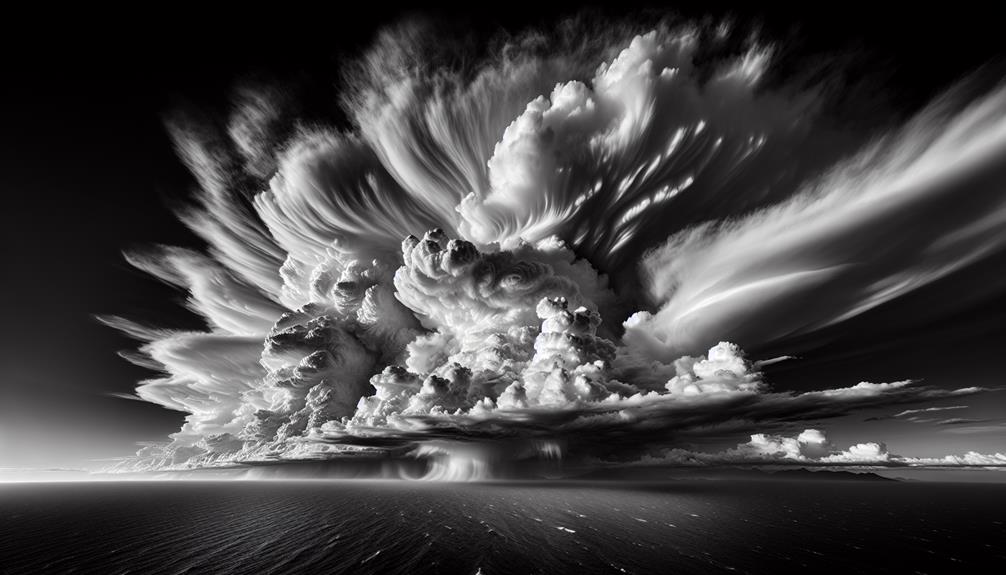We can predict storm formations effectively by analyzing a range of meteorological data. Atmospheric pressure trends help us identify regions poised for storm activity. Temperature variations, especially sharp drops, signal potential severe weather. High humidity levels and increased dew points indicate moisture-rich conditions favorable for storms. Wind patterns, including jet stream behavior and trade winds, guide storm development and trajectories. Finally, cloud formations, particularly cumulonimbus clouds, provide critical insights into storm progression. By examining these factors, we enhance our ability to forecast storms accurately and ascertain their potential impact. Continue for more detailed analysis on each metric.
Key Points
- Atmospheric pressure gradients reveal regions likely to experience storm activity.
- Temperature anomalies and sharp temperature drops can indicate imminent severe weather.
- High humidity levels and elevated dew points suggest increased potential for storm formation.
- Jet stream and trade wind patterns are crucial for predicting storm development and movement.
Atmospheric Pressure Trends
Understanding atmospheric pressure trends is vital for accurately predicting storm formations. By analyzing pressure gradients, we can identify regions where the atmosphere is primed for storm activity. Steep pressure gradients, characterized by rapid changes in pressure over a short distance, often signal the potential for severe weather. These gradients are pivotal in storm forecasting, as they help us pinpoint where storms may develop and how intense they might become.
Monitoring barometric pressure provides insights into cyclone development. Cyclones, both tropical and extratropical, form in areas of low barometric pressure where the atmosphere is unstable. A sustained drop in barometric pressure typically indicates the intensification of a cyclone, necessitating close monitoring. By tracking these pressure changes, we can better predict the path and strength of cyclones, thereby enhancing our preparedness and response strategies.
In essence, understanding atmospheric pressure trends allows us to interpret the dynamics of the atmosphere with greater accuracy. This knowledge empowers us to forecast storms more effectively, providing vital information that helps safeguard lives and property. By focusing on precise pressure data, we gain the freedom to anticipate and mitigate the impacts of severe weather.
Temperature Variations
Temperature variations play an essential role in storm formation, as they drive the convection processes that fuel storm development. When we observe substantial temperature anomalies, they often correlate with significant changes in precipitation patterns.
Warmer air masses rise, creating low-pressure zones that draw in cooler air. This movement sets the stage for storm development.
By analyzing historical temperature data, we can enhance our weather forecasting techniques. For instance, abrupt temperature drops can signal the onset of severe weather conditions. This allows us to predict and prepare for potential storm formations more accurately. The impacts of climate change exacerbate these variations, making it pivotal to adapt our forecasting models accordingly.
Understanding the relationship between temperature variations and storm formation is essential for several reasons:
- Enhanced Safety: Accurate forecasts enable communities to take preemptive measures, reducing casualties and property damage.
- Economic Stability: Predicting storms can minimize economic disruptions by allowing businesses to secure assets and maintain operations.
- Environmental Protection: Timely warnings help protect ecosystems from severe weather impacts.
Humidity Levels
As we shift our focus from temperature variations to humidity levels, it's important to recognize that high humidity greatly influences storm formation by providing the necessary moisture for cloud development and precipitation.
When atmospheric humidity increases, so does the dew point, signifying a higher moisture content in the air. This elevated dew point is a critical indicator of the air's potential to reach saturation, leading to cloud formation and, subsequently, precipitation.
We often see that regions with consistently high dew points, typically over 60°F (16°C), experience increased precipitation chances. These areas are more prone to storm development because the high moisture content facilitates the condensation processes essential for forming storm clouds.
Moreover, relative humidity levels above 70% create environments ripe for thunderstorms, especially when combined with other meteorological factors like temperature gradients.
Analyzing humidity data allows us to predict storm formations with greater accuracy. By monitoring dew points and relative humidity, we can assess the likelihood of storm development and issue timely warnings.
This data-driven approach empowers us to make informed decisions, ensuring we maintain our freedom to act swiftly and effectively in the face of impending weather threats.
Wind Patterns
How do wind patterns influence storm formations, and what specific data can we analyze to predict these phenomena?
When we examine wind patterns, we focus on the jet stream and trade winds. These atmospheric currents play pivotal roles in storm development and movement. By analyzing their behavior, we gain insights into potential storm formations.
Wind patterns affect the distribution of atmospheric pressure, temperature, and moisture—key elements in storm genesis. The jet stream, a fast-flowing air current at high altitudes, can either steer storms or contribute to their intensification by altering upper-level atmospheric conditions. Trade winds, which blow consistently from east to west in the tropics, can influence the formation and trajectory of tropical storms and hurricanes.
To predict storm formations effectively, we need to analyze:
- Jet Stream Patterns: Understanding shifts and bends in the jet stream helps us determine potential storm tracks and intensification zones.
- Trade Wind Variations: Monitoring changes in trade wind strength and direction aids in predicting tropical storm developments.
- Wind Shear: Evaluating vertical wind shear, the change in wind speed and direction with altitude, is essential for forecasting storm formation and intensity.
Cloud Formations

By closely examining cloud formations, we can gain vital insights into the development and progression of storm systems. Cumulonimbus clouds, in particular, are significant indicators due to their association with severe weather. Their vertical development suggests strong updrafts and the presence of unstable air masses. By monitoring these clouds, we can estimate precipitation potential and anticipate lightning activity.
Radar imaging plays an essential role in this analysis. It allows us to track air mass movements and the evolution of cloud structures in real-time. For instance, radar can detect the formation of supercells, which often precede tornadoes and other severe weather events. The reflectivity data from radar imaging helps us determine the intensity and type of precipitation within these clouds.
Moreover, satellite imagery complements radar data by providing a broader view of cloud formations and their progression over larger geographic areas. This combination of tools enhances our ability to predict storm behavior accurately. By integrating data from both radar and satellite sources, we can identify patterns and anomalies in cloud formations that signify imminent storm development.
Frequently Asked Questions
How Does Sea Surface Temperature Affect Storm Intensity?
When sea surface temperatures rise, storm intensity can escalate due to increased atmospheric pressure variations. This warmth fuels hurricane formation, making storms more severe. Let's monitor these temperatures to safeguard our freedom from nature's fury.
What Role Do Ocean Currents Play in Storm Development?
Ocean circulation greatly impacts storm development. Current patterns can either intensify or weaken storms. When warm currents enhance heat and moisture exchange, storm intensity increases, while cold currents tend to diminish storm strength, affecting overall dynamics.
Can Ground-Based Radar Systems Accurately Predict Storm Formations?
Did you know Doppler radar can predict storm formations with 90% accuracy? When combined with satellite imagery for storm tracking, it enhances storm prediction capabilities, providing critical data for those of us who value freedom and safety.
How Does Topography Influence the Path of a Storm?
Topography greatly influences storm movement. Mountain impact can alter storm trajectory by forcing air to rise, leading to precipitation. Terrain influence also redirects storm paths, affecting intensity and duration. Accurate mapping enhances prediction and preparedness.
Are There Any Seasonal Patterns That Affect Storm Frequency?
We've analyzed how climate change alters storm patterns. Seasonal variations in atmospheric pressure greatly impact storm frequency. These shifts lead to more frequent and intense storms, especially in regions already prone to severe weather events.


